It doesn’t get much easier or more delicious than sheet pan salmon and veggies. Roasted salmon with asparagus and crispy potatoes works equally well for a weeknight or a dinner party.
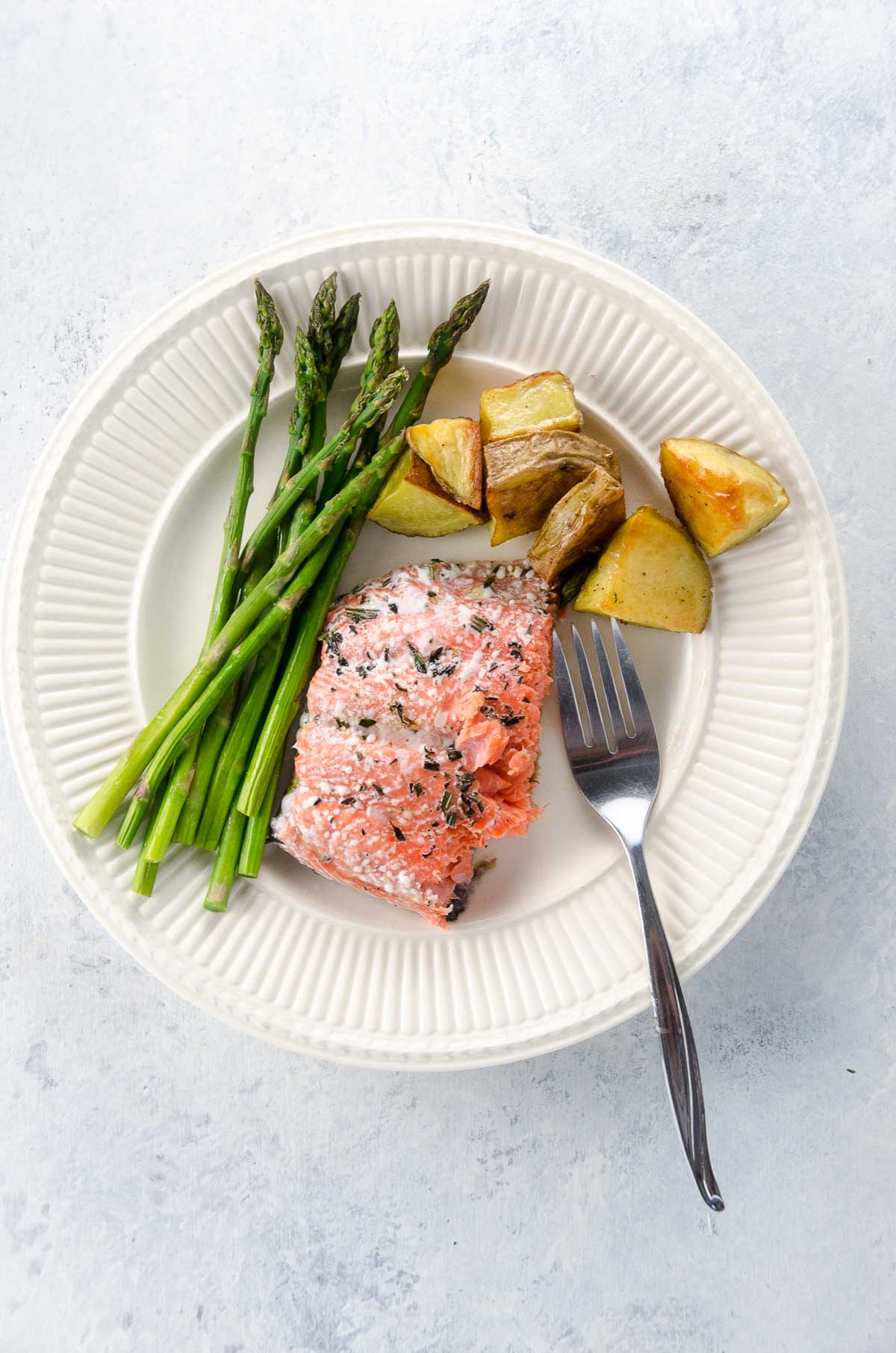
Why we love this recipe
A good sheet pan dinner is fast, fresh, and fabulous. This version transcends seasons by swapping in woodsy herbs like thyme and rosemary in winter and delicate ones like tarragon and dill in spring and summer. It's got:
- Succulent wild salmon, which is light yet super-satisfying
- Yukon gold potatoes, which have the perfect combo of starchiness to creaminess and tons of great flavor
- Quick-cooking, pencil-thin asparagus (or swap in green beans or broccolini when asparagus aren't in season)
- All tied together with a gorgeous blend of herbs, lemon, and olive oil and roasted to crisp-tender perfection
I first published this recipe here in 2017. I've since updated the post for clarity and made a few tweaks to the recipe.
What you'll need
Here's a glance at the ingredients you'll need to make this recipe.
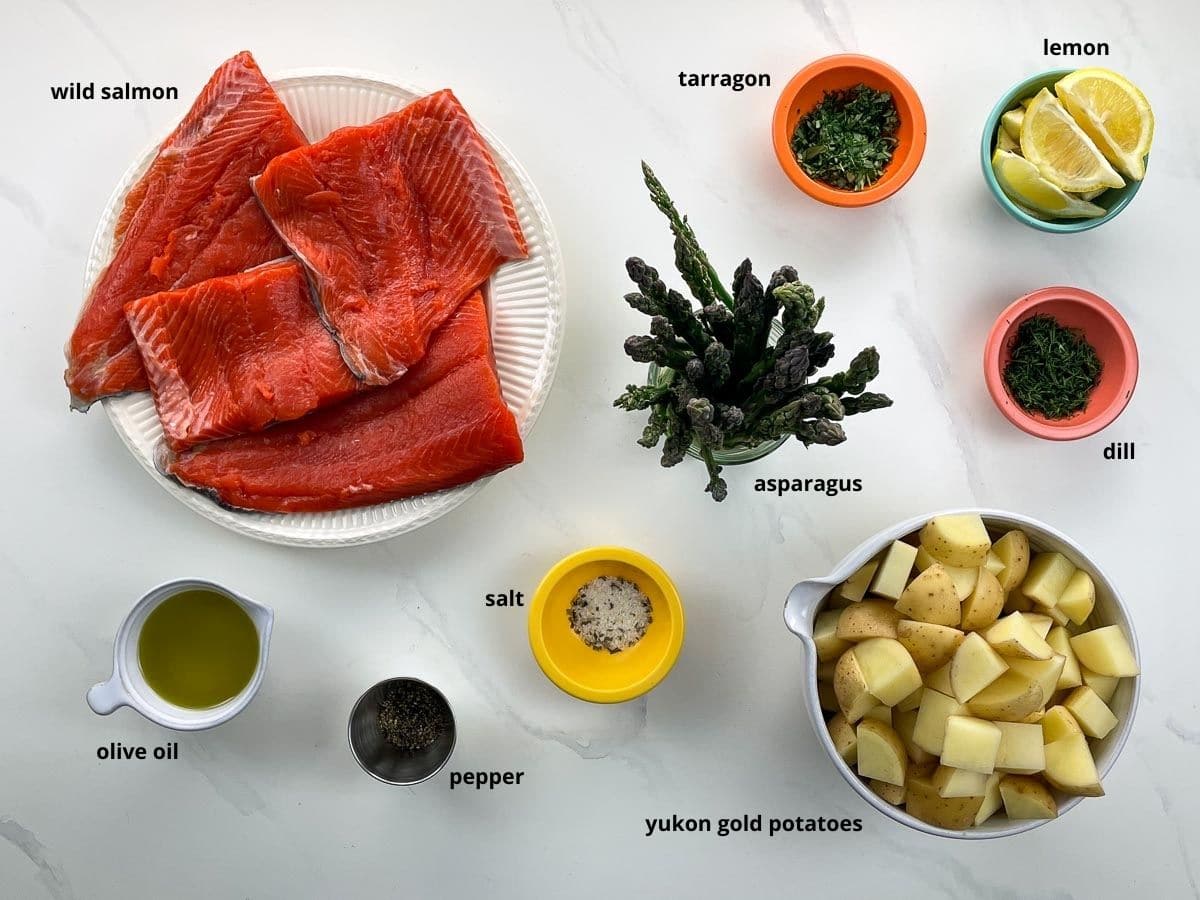
- I always choose wild salmon over farmed salmon. MSC-certified sockeye, coho, and king (chinook) salmon from Alaska are all great choices. I've pictured sockeye in the ingredient photo here.
- I like to use Yukon Gold potatoes for their excellent ratio of creaminess to starchiness, but feel free to substitute a starchy variety like Russets or Idahos if that's what you've got.
- It's great to make this recipe with pencil-thin asparagus if possible, since it needs less roasting time. If you can't find very thin asparagus, you can use thicker stalks. See the FAQ section for suggestions if asparagus is out of season.
- Depending on the season, you can easily vary your choice of fresh herbs. In the winter I like to use rosemary and thyme, and as it gets warmer I lean toward tarragon and dill. Woody winter herbs want to be cooked, and tender spring herbs can be cooked or sprinkled on after cooking (I tend to do half and half).
- You can use regular fine sea salt for sure, but herb salt quickly and easily elevates this dish.
How to make it
Here's an overview of what you'll do to make sheet pan salmon and veggies. You can see the steps in action in the video that accompanies this post, and get all the details in the recipe card below.
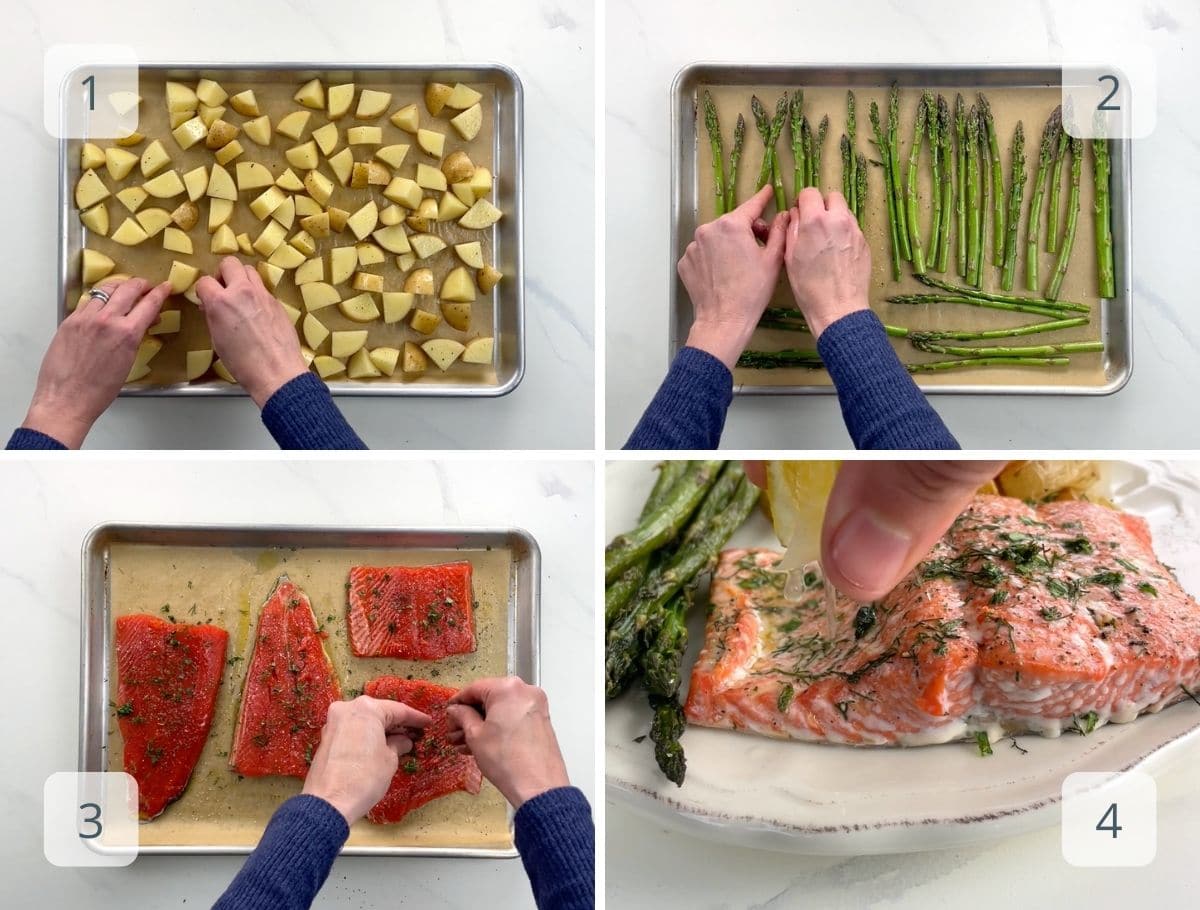
- Cut the potatoes into small bite-sized pieces, toss with some of the olive oil, salt, and pepper, and arrange on a parchment-lined baking sheet.
- Do the same with the asparagus on a separate sheet. Roast the potatoes in the bottom third of the oven for 30 minutes and the asparagus in the top third for about 15.
- When the asparagus are done, use the same pan to roast the salmon for about 10 minutes.
- Sprinkle the whole shebang with lemon juice, and serve. That's it!
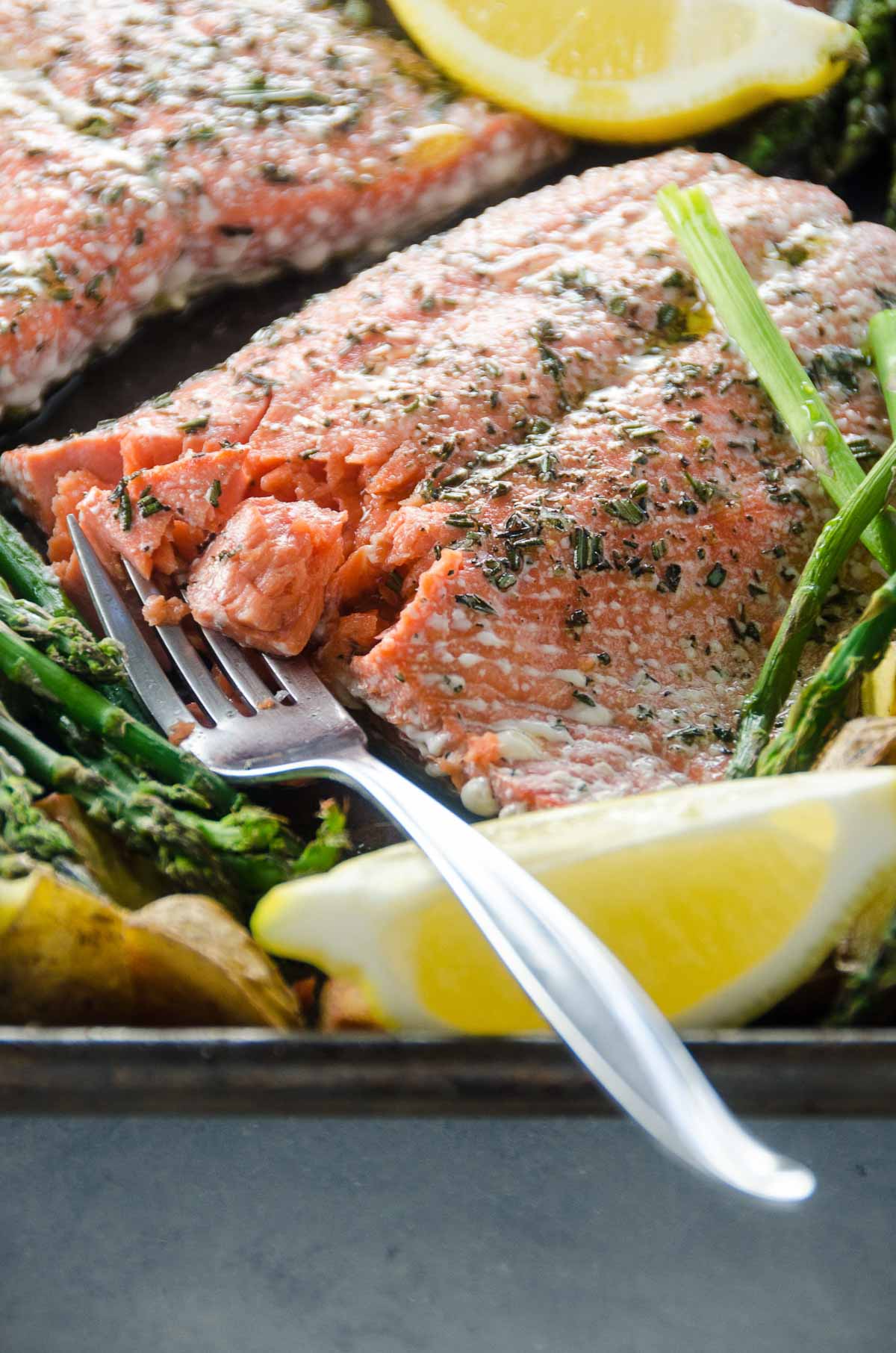
Expert tips and FAQs
For all Umami Girl recipes, I use Alaskan wild salmon for its superior sustainability, nutritional profile, and taste.
You'll find MSC-certified coho (the mildest), sockeye (brighter-colored with slightly higher fat content), and king/chinook salmon available year-round. It's fresh in season, which is great, and flash-frozen on the boat in the off-season, which is truly also great.
If asparagus are out of season, you can easily swap in green beans or broccolini with no further changes to the recipe.
Since it's relatively quick and hands-off to make, I don't go out of my way to make this recipe in advance. That said, leftovers are fabulous and can be reheated as-is or remixed into salads, sandwiches, pasta dishes, and more. They'll keep well in an airtight container in the fridge for a week.
More favorite salmon recipes
- Slow-roasted salmon with shallots and capers
- Salmon Niçoise salad platter
- Summer pasta with pesto, grilled salmon, and corn
- Seared wild salmon and lemon labneh with freekeh, kale, and dates
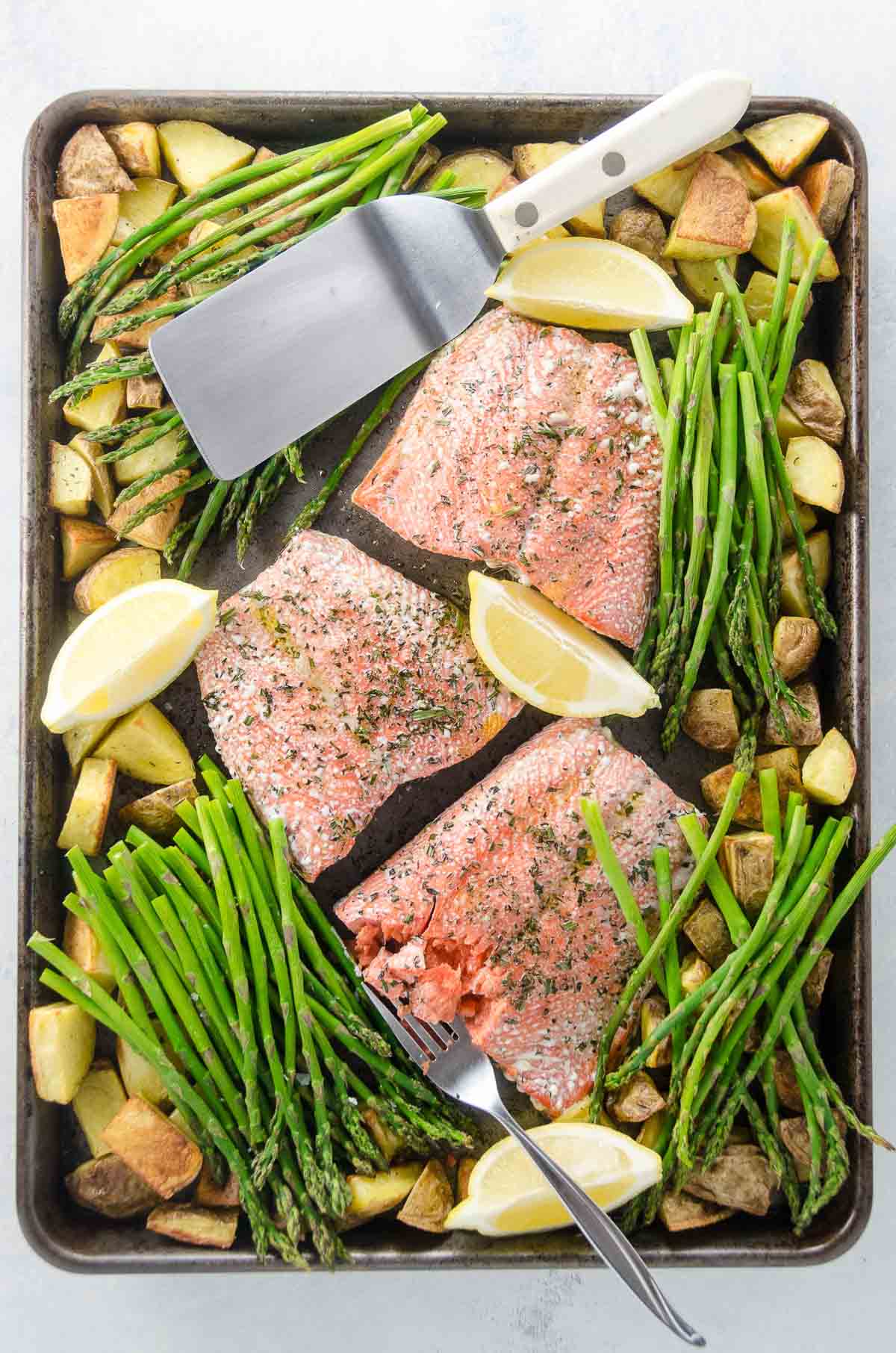
Hungry for more?
Subscribe to Umami Girl's email updates, and follow along on Instagram.
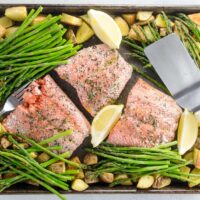
Ingredients
- 2 pounds 907 grams Yukon gold potatoes
- 3 tablespoons 45 ml olive oil, divided
- 1 teaspoon fine sea salt or herb salt (divided)
- ¾ teaspoon freshly ground black pepper (divided)
- 2 pounds 907 grams wild salmon fillet
- 1 tablespoon minced fresh tarragon (see note 1 below)
- 1 tablespoon minced fresh dill
- 1 pound 454 grams pencil-thin asparagus
- 1 lemon (cut into wedges)
Instructions
- Preheat oven to 400°F with one rack in the upper third and one rack in the lower third. Line two rimmed half-sheet pans (18-inch x 13-inch) with parchment.
- Cut potatoes into bite-sized pieces, about 1-inch by ½-inch, but don't stress. One one of the prepared sheet pans, toss with one tablespoon of the olive oil, ½ teaspoon of the salt, and ¼ teaspoon of the pepper.
- On the other sheet pan, toss the asparagus with one tablespoon of the olive oil, ¼ teaspoon of the salt, and ¼ teaspoon of the pepper. Arrange in a single layer.
- Place the potatoes on the lower oven rack and roast for 30 minutes or until crispy on the outside and tender on the inside. I don't bother to toss them during cooking, which results in the undersides being nicely browned. You can toss them halfway through if you like.
- Place the asparagus on the top rack and roast until tender and browned in spots, about 15 minutes depending on thickness. Transfer asparagus to a plate.
- Arrange salmon on the now-empty baking sheet. Rub with remaining olive oil and sprinkle with remaining salt and pepper. Sprinkle with chopped herbs. If using woody herbs like rosemary and thyme, sprinkle them all on now. If using tender herbs like tarragon and dill, you can sprinkle half now and half after roasting. Roast for about 10 minutes, until salmon is just cooked through.
- Serve with additional chopped herbs if you like and lemon wedges.
Notes
- Depending on the season, you can easily vary your choice of fresh herbs. In the winter I like to use rosemary and thyme, and as it gets warmer I lean toward tarragon and dill. Woody winter herbs want to be cooked, and tender spring herbs can be cooked or sprinkled on after cooking (I tend to do half and half).
- If asparagus are out of season, you can easily swap in green beans or broccolini with no further changes to the recipe.
- Since it's relatively quick and hands-off to make, I don't go out of my way to make this recipe in advance. That said, leftovers are fabulous and can be reheated as-is or remixed into salads, sandwiches, pasta dishes, and more. They'll keep well in an airtight container in the fridge for a week.
Nutrition
Hungry for more?
Subscribe to Umami Girl's email updates, and follow along on Instagram.


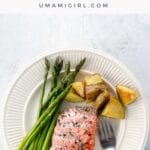
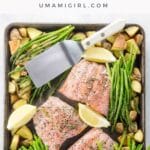
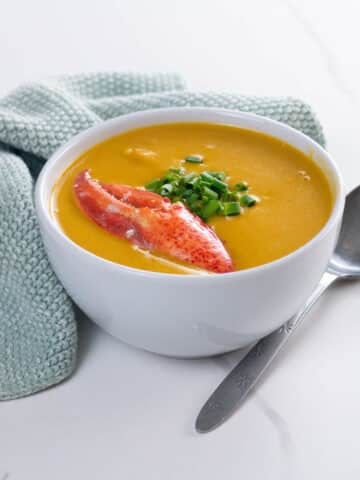
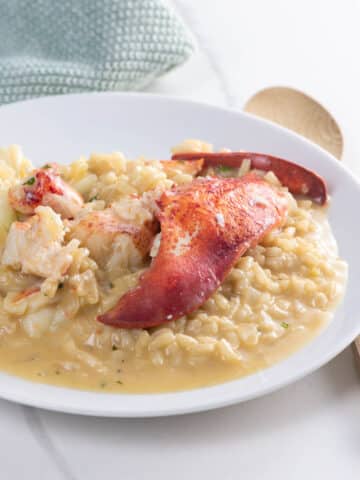
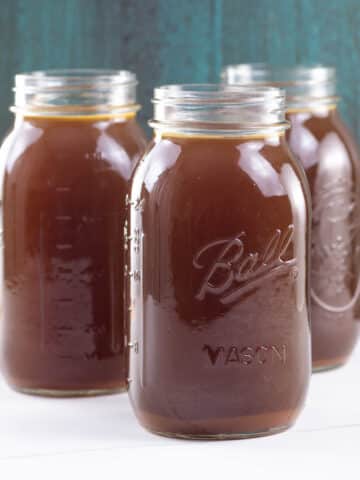
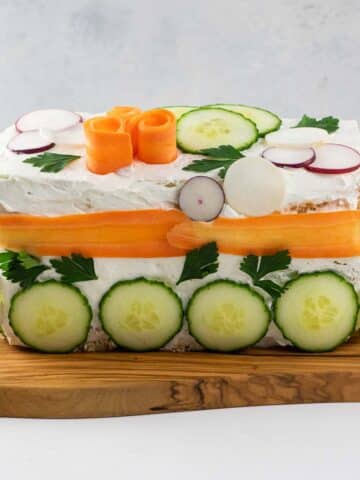

Anonymous says
Anonymous says